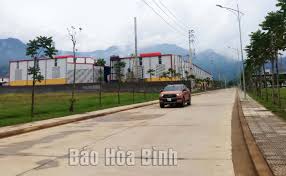
(HBO) – Developing industrial parks and clusters to attract investment will greatly help create jobs, raise income for workers, guarantee social security, and boost socio-economic development. Mindful of this, the Hoa Binh provincial Party Committee and People’s Committee have paid great attention to the issue. The province is striving to expand the area of industrial parks and clusters to about 1% of its total area - a target set in the resolution of the 17th provincial Party Congress.
Technical infrastructure of the Tien Tien industrial cluster
in Quang Tien commune, Hoa Binh city, has been developed rather comprehensively
and attracted secondary investors.
According to the initial planning, Hoa Binh
province would have eight industrial parks with a total area of over 1,500ha.
Basing on demand and implementing the 17th provincial Party Congress’s
resolution, the provincial People’s Committee ordered a survey be conducted in
some localities with investment attraction potential. Authorities have agreed
to add four industrial parks covering 1,493ha in Yen Thuy, Lac Son, and Da Bac
districts to the provincial planning for 2021 - 2030, with a vision to 2050.
That has raised the number of planned industrial
parks in Hoa Binh province to 12 with a total area of about 3,000ha. Besides,
21 industrial clusters covering 866,605ha have also been planned.
To boost technical infrastructure development
and the occupancy in industrial parks and clusters, the provincial People’s
Committee set up a steering board for infrastructure development in those
zones. This board has held quarterly or sporadic meetings to devise solutions
to difficulties facing infrastructure and secondary projects in industrial
parks and clusters.
As of August 2022, nearly 1.25 trillion VND
(50.2 million USD) was spent on developing industrial park infrastructure,
including 227.8 billion VND from the central budget, 354.1 billion VND from the
local budget, and 667 billion VND from investors.
Local industrial parks attracted 104 projects,
including 26 FDI ones worth 514.8 million USD (respectively accounting for
66.7% and 83.5% of the total in Hoa Binh) and 78 domestic ones worth nearly
13.6 trillion VND.
In 2021, businesses based in industrial parks
earned nearly 18.19 trillion VND in revenue and 690 million USD from exports,
equivalent to 44.36% of the province’s total industrial production value and
56.6% of the total overseas shipments, while contributing 250 billion VND to
the State budget.
In the first nine months of 2022, they raked in
about 15.4 trillion VND from production and business activities, up 24% year on
year, and created jobs for some 20,100 people.
From 2014 to 2022, local industrial clusters
attracted 25 investment projects, raising the total to 28 with combined capital
of almost 2.6 trillion VND. This year, they provided jobs for about 1,300
people and generated an estimated industrial production value of 1.7 trillion
VND./.
According to data from the Hoa Binh Provincial Party Committee, the industrial production index for the first six months of 2025 is estimated to have increased by 20% compared to the same period last year. This marks the highest year-on-year growth rate for this period since 2020.
In the first six months of 2025, Hoa Binh province’s export turnover was estimated at 1.145 billion USD, marking an 18.11% increase compared to the same period in 2024. Import turnover was estimated at $ 804 million, a 17.15% increase, which helped the province maintain a positive trade balance.
The lives of the ethnic minority farmers in Tan Lac district have gradually improved thanks to the new directions in agricultural production. This is a testament to the collective strength fostered through the professional associations and groups implemented by various levels of the district’s Farmers’ Union.
With the motto the "product quality comes first,” after nearly one year of establishment and operation, Muong village’s Clean Food Agricultural and Commercial Cooperative, located in Cau Hamlet, Hung Son Commune (Kim Boi district), has launched reputable, high-quality agricultural products to the market that are well-received by consumers. The products such as Muong village’s pork sausage, salt-cured chicken, and salt-cured pork hocks have gradually carved out a place in the market and they are on the path to obtaining the OCOP certification.
In the past, the phrase "bumper harvest, rock-bottom prices" was a familiar refrain for Vietnamese farmers engaged in fragmented, small-scale agriculture. But today, a new spirit is emerging across rural areas of Hoa Binh province - one of collaboration, organisation, and collective economic models that provide a stable foundation for production.
Maintaining growing area codes and packing facility codes in accordance with regulations is a mandatory requirement for agricultural products to be eligible for export. Recently, the Department of Agriculture and Environment of Hoa Binh province has intensified technical supervision of designated farming areas and packing facilities to safeguard the "green passport" that enables its products to access international markets.



